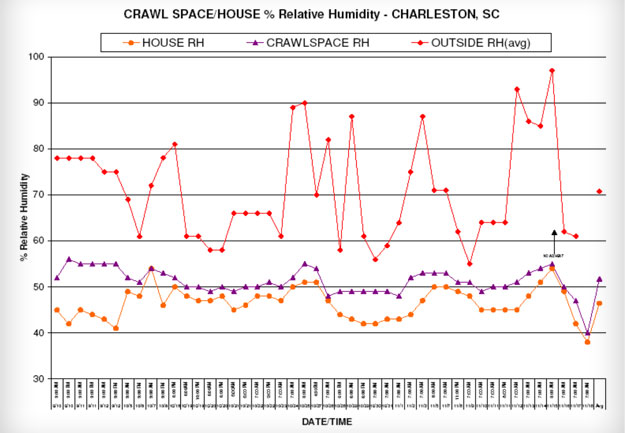
Humidity
In the summer, your crawlspace is naturally cooler than the ambient outside temperature. So, when the warm, humid outside air reaches the cooler crawlspace surface areas, the moisture condenses on framing, plumbing, wiring, insulation and especially HVAC ductwork and “sweats”, just like an iced tea glass sweats on your kitchen table in the summer. In the southeast it is not unheard of for crawlspace humidity to approach 100% and actually rain inside the crawlspace. See the Case Study.The moisture in your crawlspace creates an ideal environment for wood destroying organisms, mold, and mildew. It can saturate and destroy the effectiveness of your insulation and promote wood rot. Your house is like a giant chimney. By natural convection, air is drawn in through crawlspace vents and air leaks. Because warm air rises, the outside air is drawn through the living space (along with mold spores, odors, and moisture) and exhausted through the attic.

Mold, Mildew & Bacteria
Because of the chimney effect, the humid crawlspace air, full of mold and mildew spores and bacteria, eventually finds its way into your living space creating an unhealthy environment and causing your air conditioning to work overtime to dehumidify the air. Just a vapor barrier might help a bit, but most of the moisture is coming from outside air, not your dirt, crawlspace floor. In a recent edition of WebMD the Magazine, contributing writer Lisa Zamosky has an excellent article entitled “Green House”. The article focuses on what the homeowner can do to maintain an environmentally friendly and healthy home. Ms. Zamosky recommends several green products and suggests several routines to keep (or make) your home healthy. She also cites Jordan Josephson, MD, an internationally renowned nasal and endoscopic sinus surgeon in New York as recommending keeping humidity in your home below 60% and keeping moist areas dry as a means of minimizing mold and mildew and bacteria, three major threats to indoor air quality and pollutants that can be particularly harmful to those with allergies.

Encapsulation: The Best Solution
In a study of a home with a vented crawl space in Charleston, South Carolina, there was a very close correlation between crawlspace and living space humidity with exterior humidity. After the crawl space was encapsulated, the interior and crawl space humidity numbers dropped dramatically. After encapsulation, the exterior relative humidity varied nearly forty percent (55%-98%) during the test period. During the same time, crawlspace and living space relative humidity fluctuated a mere fifteen percent (40% -55%), always below Dr. Zamosky’s recommended figure of 60%. When considering crawl space encapsulation, most folks think of esthetics (a cleaner, less musty and more pleasant smelling home) or they think about protecting their investment (preventing mold and mildew, potential wood rot and making their home more saleable). But there are also major health considerations too – especially for those folks who battle allergies and asthma on a daily basis.
The problems common to most homes built on an unencapsulated crawl space include
- Improperly Installed Insulation
- Unnecessary Vents
- Running or Standing Water
- Mold
- Musty Air
